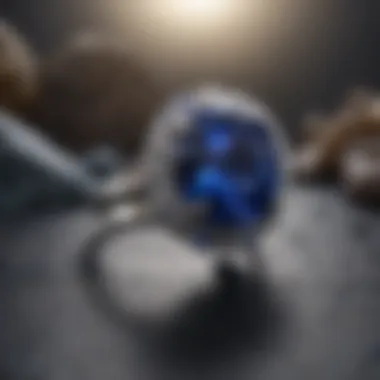Unveiling the Mystique of Blue Gemstones


Intro
Blue gemstones have always drawn attention due to their striking color, rarity, and the stories woven around them. These natural treasures often transcend their physical beauty, connecting deeply with cultural narratives and historical significance. Their usage spans from adornment in jewelry to being key artifacts in various ancient traditions. Understanding blue gemstones goes beyond mere aesthetics; it involves a rich tapestry of geological science, symbolism, and practical relevance in our lives today.
History and Origins
Overview of Geological Origins
The geological origins of blue gemstones can be as diverse as their meanings. Some, like lapis lazuli, are formed from a unique combination of minerals. Others, such as blue sapphire, come from the corundum family, resulting from high-pressure, high-temperature metamorphic processes. The location of these stones plays a significant role in their characteristics. For example, Kashmir sapphires are known for their vivid color, arising from specific geological conditions in that region.
Every gemstone carries a story of its formation, climatic conditions, and even historical events that influenced its discovery and appreciation.
Historical Significance and Cultural Impact
Throughout history, blue gemstones have served as symbols of power, protection, and status. In ancient Egypt, lapis lazuli was revered and often included in burial artifacts. It was believed to contain the spirit of the gods and to offer protection in the afterlife. Similarly, in Hindu culture, blue sapphire is associated with the deity Saturn, believed to bring prosperity and shield against misfortune.
The use of blue gemstones in royal adornments further emphasizes their significance. Royals often wore them to display wealth and authority. The famous "Star of India," a stunning blue star sapphire, exemplifies the awe these stones command.
"Blue gemstones are not just decorative; they encapsulate centuries of human belief, culture, and aspiration."
Identification and Classification
Guide to Identifying Blue Gemstones
Identifying blue gemstones involves understanding their distinct features. Each stone has its characteristics based on clarity, color saturation, and cut.
- Sapphire: Hardness on the Mohs scale is 9. Typically, a deep blue color with strong saturation. Look for inclusions and the overall brilliance.
- Aquamarine: Clear hues often with a light, watery blue. Hardness of 7.5 to 8. Check for transparency and size.
- Topaz: Can appear in several shades, including blue. Often found in a paler hue than sapphire. Hardness is 8.
- Lapis Lazuli: Notable for its deep blue color speckled with gold pyrite. Softer than the others, hardness is 5 to 5.5.
Common Types and Variations
In the realm of blue gemstones, variations are common, due to factors like geographic location and treatment methods.
- Natural vs. Treated: Many sapphires undergo heat treatment to enhance color.
- Synthetic vs. Natural: Synthetics like created sapphire are chemically identical but often lack natural inclusions.
- Different Hues: Different shades range from light aquamarine to deep royal sapphire. Each has its market value and desirability.
This categorization not only aids in identification but also enhances appreciation for each gem's unique specifics and their roles in various cultures.
Through this exploration, we uncover how blue gemstones serve as not just beautiful objects, but rich historical artifacts that resonate with human experience.
Preface to Blue Gemstones
Blue gemstones have fascinated humanity for centuries, carving a niche in both the world of science and the realms of art and culture. Their aesthetic appeal, combined with profound symbolism and meaning, makes them essential not only for collectors but also for various industries including fashion and jewelry.
Understanding blue gemstones means appreciating their unique properties and the ways they resonate within diverse cultural contexts. This article will guide you through different aspects of these captivating stones, encompassing their geological formation, cultural significance, and their role in healing, among other interesting facts.
By delving into their definition, classification, and historical relevance, readers will uncover the layers of meaning associated with blue gemstones. We’ll explore how they are perceived beyond their physical form, serving as symbols of calmness and clarity in many societies. In doing so, this exploration aims to highlight their importance, not only for enthusiasts and collectors but also for those who appreciate the stories and ideals associated with these natural wonders.
Definition and Classification
Blue gemstones are classified within a specific category based on their color and mineral composition. The most notable among them are sapphires, aquamrine, blue topaz, and turquoise. Each of these stones has unique properties that distinguish them from one another.
Typically, blue gemstones derive their color from the presence of transition metal ions. For example, sapphires predominantly display blue hues due to traces of iron and titanium. These geological characteristics determine their value and placement in the gemstone market.
Additionally, blue gemstones can be categorized based on their origins, such as natural, synthetic, and treated. Natural stones come directly from the earth, while synthetic ones are lab-created and maintain similar properties to their natural counterparts. Understanding this classification helps collectors make informed choices.
Importance in Culture and History


The significance of blue gemstones in culture and history is profound. Civilizations have embraced these stones for their beauty and rarity, incorporating them into royal adornments and religious artifacts. For instance, sapphires were favored by monarchs for centuries, believed to symbolize wisdom and nobility.
In ancient cultures, stones like turquoise held spiritual importance, often associated with protection and balance. These beliefs can be traced back to rituals and customs, which have endured through time. Such historical narratives underlie the ongoing relevance of blue gemstones in not just jewelry, but in the broader aspects of life and spirituality.
"Blue gemstones embody not just beauty, but also the essence of culture and tradition across generations."
Today, the fascination with these stones continues. They are not only elements of luxury but also carry meanings of peace and tranquility, making them favored choices for engagement rings and other personal jewelry pieces. Embracing the historical significance of these gemstones allows for a deeper appreciation of their value in modern contexts.
Types of Blue Gemstones
The examination of blue gemstones reveals their unique qualities that distinguish them from other color variants. Different types of blue gemstones serve various purposes, both aesthetic and symbolic. Understanding these distinctions is essential for those who collect or utilize these stones in jewelry or cultural practices. This section provides an in-depth analysis of significant types of blue gemstones and their individual characteristics, which contribute to their desirability and value.
Sapphire
Geological Formation
The geological formation of sapphires involves high-pressure and high-temperature conditions found in metamorphic rocks. This process results in corundum, the mineral that creates sapphires. The hardness of sapphires, rated at nine on the Mohs scale, is a fundamental aspect that offers durability. This characteristic makes sapphire a popular choice for engagement rings and everyday jewelry. The origins of sapphires vary with locality, giving them diverse qualities based on the deposit environment.
Color Varieties
Sapphires are well-known for their range of color varieties, with the most celebrated being the vivid blue. However, they can also appear in shades including pink, yellow, and even colorless. This versatility makes them appealing to a wider audience. While blue sapphires are often more sought after, the value of other colors can sometimes rival them depending on rarity. As such, collectors appreciate the unique variations that each sapphire presents.
Cultural Significance
Historically, sapphires have held significant meaning in various cultures. They are often associated with nobility and wisdom. In many societies, blue sapphires were believed to protect wearers from envy and harm. Their enduring value in history provides depth to their cultural significance. This connection to heritage and tradition enhances the appeal of sapphires for collectors seeking not just beauty, but a story behind the gemstone.
Blue Topaz
Formation Process
Blue topaz forms through a process that involves the cooling of magma which contributes to its exceptional clarity. This gemstone is often treated to achieve its characteristic blue color, primarily through radiative treatments. The transparency and brilliance of blue topaz make it a favored choice among jewelers. As a less expensive alternative to premium stones like sapphire, its accessibility opens up options for enthusiasts looking to include vibrant blue stones in their collection.
Uses in Jewelry
Due to its appealing color and affordability, blue topaz enjoys various applications within jewelry. It serves well in rings, necklaces, and earrings, allowing for creative designs. The stone's durability complements its aesthetics, making blue topaz a practical choice for everyday wear. This combination of qualities contributes significantly to its popularity in the jewelry market.
Historical Context
Dating back centuries, blue topaz has appeared in various forms of adornment, holding historical significance. Ancient civilizations viewed topaz as a stone of protection and good fortune. In modern times, its interpretation has evolved but retains connections to tradition. Such historical relevance attracts collectors who appreciate the narratives associated with these vibrant stones.
Aquamarine
Properties and Characteristics
Aquamarine is valued for its serene blue hues reminiscent of the ocean. The stone's composition, rich in beryllium, contributes to its clarity and brilliance. Its moderate hardness at 7.5 to 8 on the Mohs scale provides a balance between durability and delicacy. These properties make aquamarine a popular choice in various jewelry designs, particularly in pieces meant for special occasions.
Symbolic Interpretations
Aquamarine symbolizes tranquility and harmony, making it a significant gemstone in many cultures. It is often associated with the healing powers of water and the calming aspects of the sea. Such symbolism appeals to individuals seeking both beauty and deeper significance in their gemstones, thereby enhancing aquamarine's desirability.
Folklore and Mythology
In folklore, aquamarine has been tied to tales of sailors and marine deities. Ancient Greeks believed that aquamarine offered protection and good luck for those at sea. Today, this association endures, adding another layer of meaning that collectors often value. The mythological links elevate aquamarine beyond a mere decorative stone, making it a conversation piece within personal collections.
Turquoise
Mineral Composition


Turquoise forms through the interaction of copper and aluminum in acidic environments, resulting in its distinctive color. Its porous nature can influence its durability and wearability. This characteristic demands care in maintenance, which collectors must consider to preserve the stone's integrity. Its unique formation process lends itself to individual variations that make each piece distinct.
Traditional Uses
Traditionally, turquoise has been used in various cultures as a protective talisman. Many indigenous groups incorporated it into jewelry and decorative items, believing it carried protective properties. These traditional uses add layers of history and cultural significance that collectors often seek in their selections.
Modern Relevance
Today, turquoise remains popular in fashion, often celebrated for its bold color and artisanal quality. Its presence in contemporary jewelry signifies a blend of traditional craftsmanship with modern designs. This ongoing relevance creates opportunities for collectors and enthusiasts alike to engage with turquoise as both an artistic and historical piece.
The Meaning Behind Blue Gemstones
The exploration of blue gemstones often extends beyond their aesthetic appeal. They possess deep meanings and symbols that have been recognized across different societies. This section dissects the components that contribute to the significance of blue gemstones. Understanding these meanings can provide a richer context for their value not only as decorative items but also as symbols reflecting emotional and cultural dimensions.
Symbolism of Blue Colors
Calmness and Clarity
Calmness and clarity are perhaps two of the most prominent attributes associated with blue colors. These qualities foster a sense of peace, making blue gemstones popular choices in various contexts, including jewelry and decor. The striking feature of calmness is its ability to soothe the mind and promote serenity. In stressful situations, blue hues can aid in creating an atmosphere that encourages tranquility. This characteristic is especially beneficial for individuals seeking solace amidst daily chaos.
Moreover, clarity relates to the freshness of thought and perspective. In a world filled with distractions, blue gemstones remind us of clarity in communication and purpose. One might argue that their calming properties make them effective ornamental pieces that promote mental well-being. Thus, from both psychological and aesthetic viewpoints, these stones enhance our environments.
Communication and Expression
Communication and expression find a unique place within the symbolism of blue gemstones. These stones embody the essence of effective communication, often resonating with honesty and trustworthiness. This characteristic appeals to many who regard blue gemstones as talismans for clear expression of thoughts and feelings. Their historical association with communication is significant in cultures that value openness.
The unique feature of blue hues is their emotional resonance. People often feel encouraged to speak freely and expressively in the presence of these colors. However, there can be challenges, such as the misconception that blue may signify sadness. Despite this, the overall perception leans towards positivity and openness. Hence, these qualities make blue gemstones a worthwhile exploration in the context of fostering genuine interactions.
Healing Properties
Psychological Benefits
The psychological benefits of blue gemstones present another compelling aspect of their significance. Widely, these stones are renowned for their calming effects, promoting a reduction in anxiety and fostering emotional stability. The tranquility associated with these colors is incorporated into healing practices. They are recognized for helping individuals achieve a centered and balanced state of mind.
Their key characteristic lies in stress relief. In therapeutic settings, blue gemstones are often used to aid in relaxation and emotional healing. Those who struggle with emotional turmoil may find them particularly beneficial. However, it's essential to note that the outcomes vary from person to person, as individual experiences with gemstones can differ significantly.
Physical Healing Attributes
Physical healing attributes of blue gemstones deserve attention as well. Certain stones, such as aquamarine and lapis lazuli, are considered beneficial for health. They are thought to enhance physical well-being, with claims ranging from boosting the immune system to alleviating pain. This connection between physicality and these stones expands their role beyond aesthetics into the realm of holistic health.
The unique feature of these stones is their holistic approach to healing. They are often integrated into practices like crystal therapy, where physical ailments are treated alongside emotional issues. This dual focus can sometimes overwhelm individuals who seek straightforward answers to their health concerns. It's crucial for prospective users of blue gemstones to remain informed and critical about their benefits.
Cultural Significance
Historical Perspectives
Ancient Civilizations
Blue gemstones have played a crucial role in ancient civilizations. They were not merely decorative items; they held significant value in trade, rituals, and symbolism. For example, ancient Egyptians revered lapis lazuli for its vibrant color and rarity. This gemstone was often associated with royalty and the divine, linking it to their gods. The Egyptians believed that wearing lapis lazuli could offer protection and wisdom.
Moreover, in Mesopotamia, blue stones like turquoise were coveted for their beauty and perceived mystical properties. Ancient civilizations invested heavily in these gems, seeing them as powerful talismans. This historic relationship with blue stones provides a fascinating backdrop that enriches our understanding of their significance in culture and community.
Religious Interpretations
Religious interpretations of blue gemstones reveal their profound meanings across cultures. In many spiritual traditions, blue symbolizes truth, fidelity, and divine connection. For instance, in Christianity, sapphires are associated with heaven and divine favor. They often adorn religious artifacts, believed to enhance spiritual insights and provide divine protection.
Similarly, in Hinduism, blue is the color of Krishna, symbolizing love and compassion. The use of gemstones in religious contexts underscores their importance. It shows that these stones are not just beautiful but hold deeper implications for spirituality and community practices.
Modern Usage


Fashion and Popular Culture
In contemporary society, blue gemstones have become highly popular in fashion and popular culture. Designers frequently incorporate sapphires and turquoise into collections, reflecting their allure and sophistication. Celebrities often choose blue gemstones for red carpet events, showcasing their timeless elegance.
The emotional connection that people have with blue stones enhances their appeal. This deep-rooted history contributes to their status in the fashion world. However, while they are fashionable, the environmental impact of gemstone mining raises questions. Therefore, consumers must consider ethical sourcing when selecting blue gemstones.
Investment and Collectibility
The investment potential of blue gemstones is another significant aspect of their cultural significance. Collectors often see them as tangible assets. High-quality sapphires, for instance, can appreciate significantly over time. The rarity of exceptional blue stones makes them sought after, adding to their collectibility.
Moreover, understanding market trends can help collectors make informed decisions. Both the aesthetic beauty and potential for value appreciation make blue gemstones appealing to investors. Nevertheless, one must be cautious about authenticity and quality. It's essential to rely on certified evaluations when investing in these stones.
Care and Maintenance of Blue Gemstones
The allure of blue gemstones goes beyond their beauty. Proper care and maintenance are essential for preserving their integrity and aesthetic appeal. Understanding how to care for these stones ensures they remain stunning and retain their value over time. By adopting specific cleaning techniques and storage solutions, enthusiasts can protect their collections from damage and deterioration.
Cleaning Techniques
Recommended Products
When it comes to cleaning blue gemstones, choosing the right products is crucial. Gentle, pH-balanced cleaners are widely recommended. They do not contain harsh chemicals that can harm the stone's surface. Additionally, cleaning solutions designed specifically for gemstone care often include natural ingredients that enhance shine without causing scratches.
One good option is a mild soap mixed with warm water. This method is simple and effective. For a more specialized product, gemstone cleaning kits can be beneficial. They usually come with soft brushes and cloths, tailored for various types of blue gemstones. These products not only make cleaning easier but also minimize the risk of damage.
However, it’s important to avoid cleaning agents containing vinegar or ammonia. These can react with the elements in certain gemstones, damaging their finish or even altering their color. Thus, understanding the material composition of the gemstone is vital when selecting cleaning products.
Avoiding Damage
Avoiding damage is integral to maintaining blue gemstones. Understanding how to handle, clean, and store these stones will prevent unintentional harm. One often-overlooked aspect is the physical impact of dropping or striking the gemstone against hard surfaces. Using padded containers for storage can mitigate this risk.
During cleaning, it's recommended to use soft cotton cloths and gentle brushes. These materials are less likely to scratch the surface compared to abrasive materials. Additionally, be mindful when wearing blue gemstone jewelry. Remove it before engaging in activities that may cause impact or exposure to harsh chemicals. By taking these precautions, owners can help their gemstones maintain both physical and aesthetic integrity.
Storage Solutions
Humidity and Temperature Considerations
Proper storage of blue gemstones is crucial for preservation. Humidity and temperature significantly affect these stones. Ideally, they should be stored in a dry environment with consistent temperature, away from direct sunlight. This helps to avoid thermal shock or changes in appearance caused by temperature fluctuations.
A humidity level of around 40-60% is optimal for most blue gemstones. If the air is too dry, some stones may crack, while excess moisture can lead to mold and other issues. Using silica gel packets in storage containers can help control moisture levels effectively. This simple measure can prolong the life of the stones.
Preventing Scratches
Preventing scratches is another critical component of gemstone care. Blue gemstones can be vulnerable to scratches, especially softer stones like turquoise. To prevent this, storing them separately in individual pouches or wrapped in cloth helps. This isolation prevents them from rubbing against each other, which could lead to scratches or chips.
Also, consider using a jewelry box with compartments. Such a box protects the stones and keeps them organized. Additional padding inside the compartments provides further protection against physical damage. These thoughtful measures enhance the longevity of gemstones, allowing them to remain in pristine condition for years.
"Maintaining blue gemstones requires careful thought and practice, ensuring that their beauty and value endure over time."
The End
Blue gemstones serve not only as beautiful natural phenomena but also as significant cultural artifacts. Their relevance extends from ancient civilizations to modern contexts, bridging time and space while enriching personal narratives. Understanding blue gemstones involves examining their geological origins, beautiful variations, and profound meanings.
Recap of Significance
The journey through blue gemstones emphasizes their multifaceted nature. Each stone possesses unique characteristics and symbolism, resulting in a rich tapestry of meanings. For instance, sapphires are revered for wisdom and nobility, while aquamarine is associated with tranquility and clarity. Such associations foster personal connections to artistry and heritage.
In terms of care and maintenance, knowing how to clean and store these stones adds an essential layer to their significance. Proper handling ensures their longevity, thus preserving the stories they tell and memories they hold. The impact of these stones is not limited to jewelry; they transcend aesthetic boundaries and find their place in healing, meditation, and even investment.
"Blue gemstones embody serenity and depth, capturing human emotions across various cultures."
Future Perspectives
The evolving landscape of blue gemstones suggests a bright future for collectors and enthusiasts. As interest grows in ethical sourcing and sustainable practices, the demand for responsibly sourced gemstones increases. Innovations in treatment techniques and synthetic alternatives can also reshape the market. This could lead collectors to explore new avenues, expanding their knowledge and appreciation further.
Moreover, the role of blue gemstones within society continues to transform. Their applications in modern design and technology may open doors for creative adaptations. As these stones find their way into contemporary art and wellness practices, their value and significance remain ever-present. Thus, understanding them not only enriches our current perspectives but also prepares us for future explorations in the realm of natural beauty.



